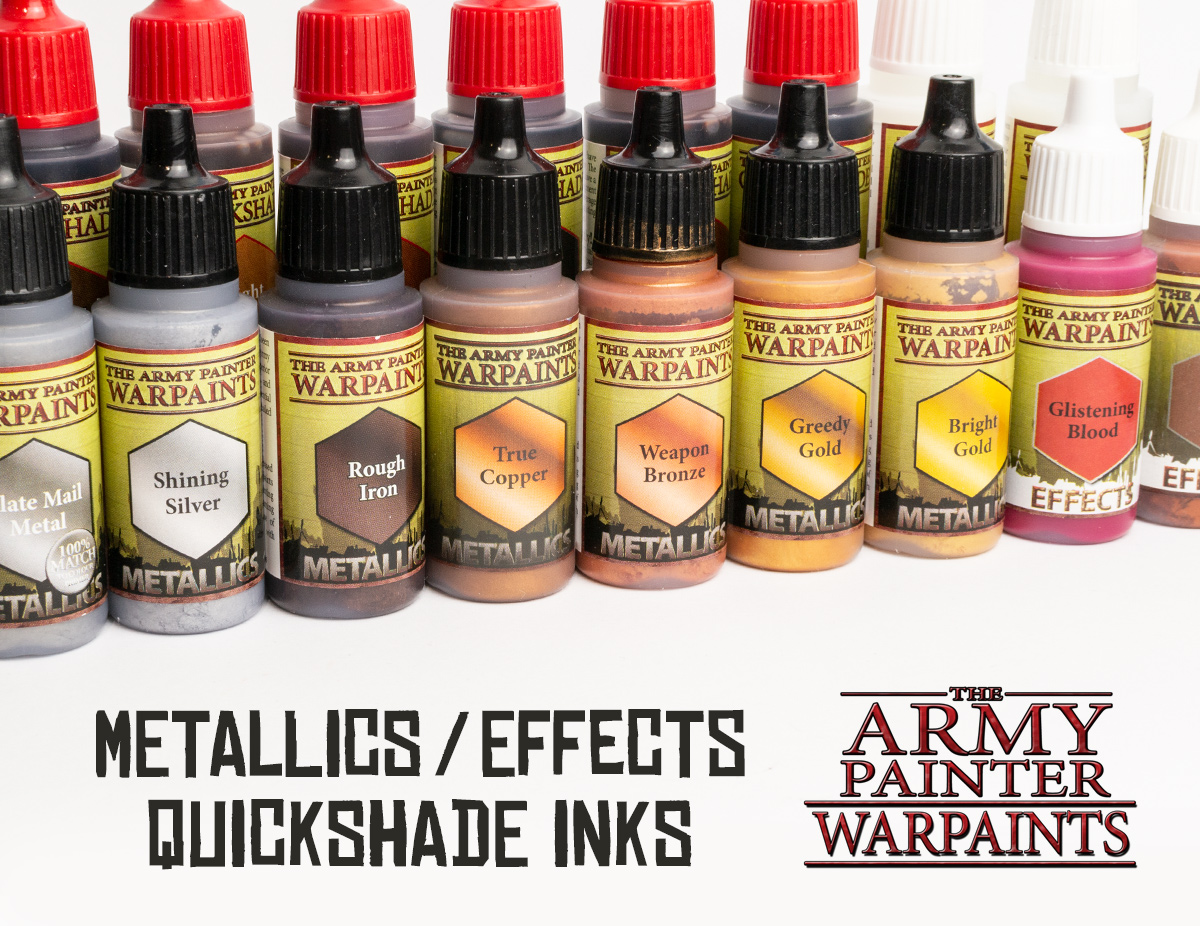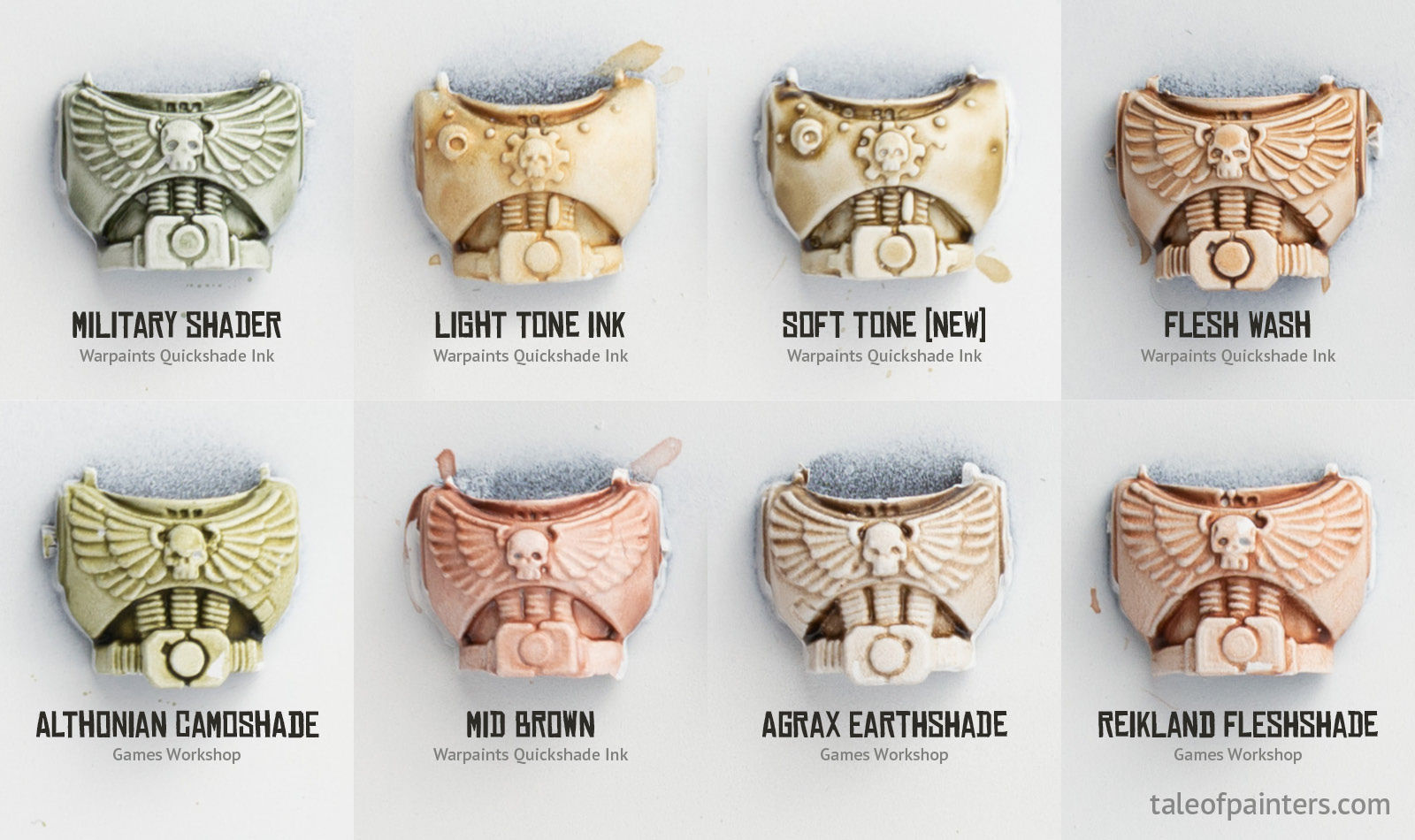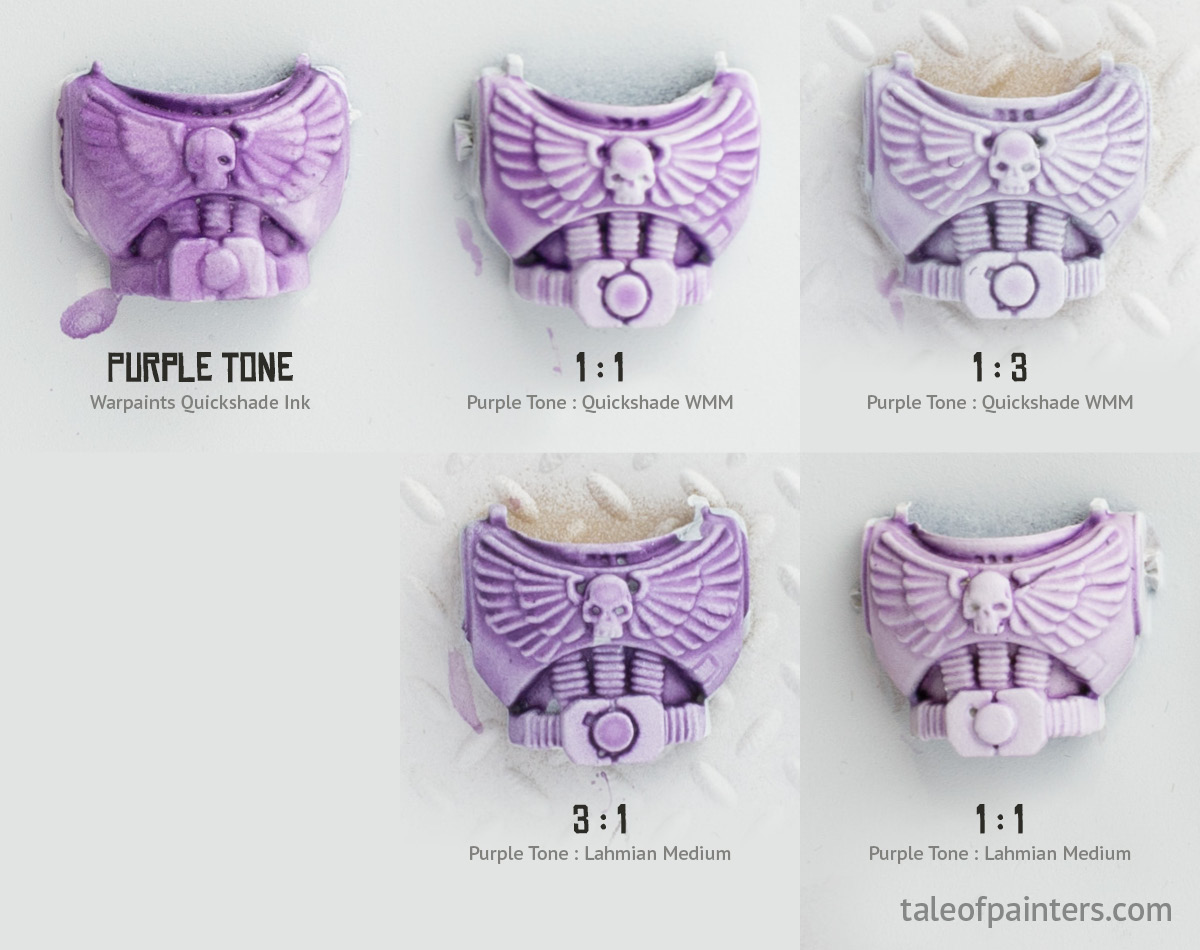Here we go, part two of our epic review of The Army Painter’s Warpaints range, the most comprehevise Warpaints review on the web! In part one, we took a look at each of their 96 acrylic paints, this time, we see how their metallics, Quickshade Inks and effect paints compete. Brace yourselves for another long post.


We’ve run down the basics of the Warpaints paint range in part one, so check it out if you haven’t already:
This time, we cover the washes, effect paints and metallics that complement their 96 acrylic paints.
Please note: This review was updated and expanded in 2023.
Quickshade Washes review
The Army Painter’s Quickshade Washes come in bottles of 18 ml at 2.75 €/£2.25 (0.153 €/£0.125 per ml), so are almost half the price of Citadel Shades (0.153 € per ml compared to 0.263 € per ml for Citadel)!
Please note: The figures refer to the time of publication of this review. Prices have risen slightly since then.
I was pleased to hear that The Army Painter expanded their Quickshade Inks with four new hues, bringing the range to 11 washes in total. The new additions are Flesh Wash, Mid Brown, Light Tone and Military Shader.


Military Shader: This is a drab green wash. Compared to GW Althonian Camoshade, it’s less yellowish. I like it quite much, I think it’s great for shading drab or muted greens when you don’t want that yellowish hue of Althonian Camoshade.
Green Tone, Purple Tone, Blue Tone: We already reviewed these inks a while ago, check out the review here. For reference, Green Tone Ink is slightly more muted than GW Biel-Tan Green, Purple Tone is a very close match to GW Druchii Violet, Blue Tone is less blackish and than GW Drakenhof Nightshade.
Dark Tone, Strong Tone: Also reviewed earlier, learn more about them here. Dark Tone Ink is a perfect match for GW’s old Badab Black or (old formula) Nuln Oil, while Strong Tone is a darker, more blackish-brown compared to GW Agrax Earthshade (but a very close match for GW’s old Devlan Mud). Please note that The Army Painter seems to have changed Soft Tone Ink since our review:
Soft Tone – Soft Tone Ink used to be quite similar to GW’s old Gryphonne Sepia or new Seraphim Sepia Shade, but The Army Painter seems to have changed it into a more mid-brown wash, as seen as on the colour swatch. It’s actually quite similar to GW Agrax Earthshade. Old Soft Tone Ink seems now to be Light Tone Ink.
Note: Dark Tone, Strong Tone and Soft Tone are supposed to match The Army Painter’s Quickshade “dip” range, though I can’ comment on that as I don’t have their dips for comparison.


Red Tone: Already reviewed a while ago.
Flesh Wash: A reddish-brown wash for shading caucasian flesh, also useful for shading gold and copper. Compared to Reikland Fleshshade, it’s a nuance less reddish and it settles better in the recesses.
Mid Brown: This was quite a surprise, as it’s an even more reddish brown wash than Flesh Wash. It’s much more reddish than it appears on the colour swatch. It’s actually pretty close to GW Reikland Fleshshade. Compared to other Quickshade Inks, it didn’t settle quite as nicely in the recesses. Maybe my bottle wasn’t properly mixed.
Light Tone: Light Tone is a sepia brown, similar to GW Seraphim Sepia.
All in all, I’m quite fond of The Army Painter’s washes. They have more body than Citadel Shades, and most of them go on very evenly. They are also quite affordable, which is a plus.
Effect Paints
The Effect paints range features a mix of useful additives and varnishes, as well as some specially formulated paints to create special effects like blood, slime and weathering. Let’s take a closer look.


Brush-On Primer: A medium grey paint that can be applied as a primer over bare metal and plastic. The consistency of the primer is nice, it goes smoothly on models and doesn’t drip off like some thinner brush-on primers. The durability can’t match a spray primer of course.
Glistening Blood, Wet Mud, Disgusting Slime: If you expect these to match Citadel’s Technical paints, than you will be disappointed. These are essentially “just” glossy paints, made to stand out after a coat of matt varnish for a wet effect. Compared to GW Blood for the Blood Good or Nurgle’s Rot, they are lacking the gooey gel-like consistency (you can find out more about Citadel Technical paints here). The colours are also quite garish. I recommend applying these paints with a sponge or by flicking them from your brush for cool splatter effects.
Dry Rust: A rusty orange with a hint of brown. Unlike GW’s Ryza Rust, the consistency is similar to regular acrylic (War)paints with a matt finish. Can be mixed with Quickshade Wash Mixing Medium and applied as a wash, or used for drybrushing or stippling. Essentially, it’s just orange paint, quite unexciting.


Anti-Shine Matt Varnish: A very nice water-based matt varnish that can be applied with a brush or an airbrush. The finish is similar to the natural finish of most hobby paints like Warpaints or Citadel paints, and slightly more matt as more satin finish paints like Vallejo Game Colour or Privateer Press. It doesn’t dull your colours. I recommend thin coats as the drying time will increase for thicker applications. Fortunately, the varnish doesn’t frost even when you accidentally put on too much varnish. The varnish is also fully transparent and doesn’t tint or yellow your paint job.
Quickshade Wash Mixing Medium: A transparent fluid designed to dilute Quickshade Washes (or Citadel Shades) without changing the flow, making the wash more translucent and helping to settle the pigments better in the recesses. As you can see, I made some experiments on how this mixing medium changes the properties of a wash.


Here you can see Purple Tone wash straight from the bottle compared to several mixes with GW Lahmian Medium and Quickshade Wash Mixing Medium in different ratios. Compared to GW’s Lahmian Medium, QWMM has more “body” and is a bit thicker, you’ll need more of it to thin down your wash (or less wash, depending on the point of view).
You can see that QWMM reduces the staining of flat surfaces slightly better than Lahmian Medium does, but it makes the wash also a bit paler. Lahmian Medium makes the wash more transparent in general, and there is more staining. Both mediums have their merits. I ranked and reviewed several acrylic mediums including Lahmian Medium and Contrast Medium in this post, so go check it out.
Warpaints Mixing Medium: Another transparent fluid, this medium is for thinning and diluting acrylic paints without changing the flow. It makes your paints more transparent. It’s basically paint without pigments. Perfect when building up highlights for blending layers.
Gloss Varnish: A water-based gloss varnish that can be applied with a brush or an airbrush. Perfect for adding a wet or gloss effect to specific spots like gems, tongues, mouths, acid and so on. The varnish is completely transparent and doesn’t tint your paint job (there are some varnishes out there which have a slight yellowish tint).
Warpaints metallics review
The Warpaints range features 8 metallic paints. Like most other miniature paint ranges, The Army Painter’s metallics are water-based and non-toxic. The paints require a little bit of shaking, but they don’t separate as badly as some of the Citadel metallic paints. The metallic pigments used are a bit on the grainier side, like most of the cheaper Citadel metallics that don’t come in the white cap bottles.


Bright Gold: A light to medium gold, lighter and more yellowish than on the paint swatch. Quite similar to GW Auric Armour Gold. It’s not as thin as some other gold paints on the market and covers in about three thin coats.
Greedy Gold: A medium gold with a hint of orange. Very similar to GW Gehenna’s Gold, coverage is not too bad for gold paint, but it can’t match the opacity of GW’s Retributor Armour.
True Copper: Despite the name, I found it to be actually more of a brassy paint, similar to GW Balthasar Gold but lighter. More brownish and muted than on the paint swatch.
Weapon Bronze: A bright and vibrant bronze paint with mediocre coverage. Similar to GW Brass Scorpion, but slightly lighter. Lighter in real life than on the colour swatch.
Shining Silver: A very bright silver, similar to GW Runefang Silver, but with better coverage, though not as good as Stormhost Silver.
Plate Mail Metal: A medium silver paint, close to GW Ironbreaker, but the coverage is slightly better. My recommended highlight colour: Shining Silver.
Gun Metal: A dark silver, similar to GW’s Leadbelcher, but while Leadbelcher has a nuance of oily brown, Gun Metal is slightly more neutral, cooler silver. My recommended highlight colour: Plate Mail Metal.
Rough Iron: unlike the paint swatch, it’s not a dark silver, but more like a dark copper. A good match for GW Warplock Bronze.
I noticed The Army Painter seemed to have changed their silver paints. In the early days of the Warpaints range, the formula used to be almost identical to the silver paints from the old Citadel paint range (Mithril Silver, Chainmail, Boltgun Metal). Super-fine pigments, smooth application, almost perfect coverage. Their “new” current generation of metallic paints are by no means bad, but I feel that their old versions were superior. They are also no match to Citadel’s more expensive white cap metallics or metallic paints like Scale75 Alchemy, Vallejo Metal Color, or Two Thin Coats metallics.
Where to get Warpaints
If your local gaming store doesn’t stock The Army Painter products, you can find them online at our partner shops Wayland Games, Element Games, Firestorm Games, and Taschengelddieb. Placing your order by following these links will support Tale of Painters at no extra cost for you at all. Much appreciated.
6.5Score
Pros
- Average to solid paint quality, decent opacity
- Nice selection of colours with a few unique ones that complement the Citadel range nicely
- Very nice washes
- 18ml dropper bottles with agitators
- Widely available and affordable
- Whole "eco system" with matching Colour Primers and airbrush paints
Cons
- Metallics have rather coarse metallic flakes and average opacity
- Effect paints are just glossy paints and no comparison to Citadel's paints
- Sometimes you get a bottle that hasn't properly blended
Final Verdict
The Army Painter's Warpaints are a solid range of paints that are widely available and are a more affordable alternative to Citadel paints. Most paints cover well, but in terms of quality and consistency, Warpaints are average and have to admit defeat to higher quality (and more expensive) paints such as Scale75, ProAcryl, and Two Thin Coats. Their biggest weakness seems to be their binder, as every now and then you get a bottle that has not been properly blended and became heavily separated, which results in the annoying "only transparent medium comes out" effect that requires a lot of shaking and stirring to fix it.









I love the AP washes. I have at least the standard Citadel ones but use them when the result can be under par without hurting but the AP ones, especially when mixed in with a little of the QWMM do perform great. On the metallics I shortly discovered Dark Star Miniatures Molten Metal range and could try some up to now (mostly a gold and several steel tones as well as graphite) and they are pretty amazing. more costly than AP but cheaper then Citadel they come in 18 ml dropper bottles which already have an agitator ball inside they are my go to for metallics at the moment, very special variants like Vallejos Tinny Tin not accounted for.
the tall GW wash bottes are prone to fall over, especially if you paint with your kids 😉
@ 40KADDICT
Yesterday it happend to me too… Nuln Oil left (like you mentioned) a white Crust.
It was shaken for about 30 Sec. (with Steel Shakers) and only one drop of Lahmian Medium was mixed in.:(
Army Painter Dark Tone worked like a charm.
I know this. I stopped using Nuln Oil long time ago. It's really not a good product.
Seeing lots of love lately for the Quickshades. Gonna have to cave and give them a try at some point. Great review guys!
I use whatever paints work, perfectly happy with a mix of Citadel, Valejo, Army Painter and even craft and art acrylics. The Quickshades are the best though. After Seraphim Sepia left a crusty white deposit on a Hive Tyrant wings I stopped using it.
Now some will say it wasn't shaken enough,, I put on too much or it was mixed with contaminated water (even if it wasn't mixed with anything). All that could be true but whenever I've used it since and shook it relentlessly it's done the same thing.
And yet I don't need to jump through any hoops with the Army Painter shades a d get the result I'm after. It's a no brainer when you add the better value in. I'm interested in the Rough Iron paint as Warplock Bronze is an amazing colour and I start most of my metallics with it but couldn't find a match for better value.